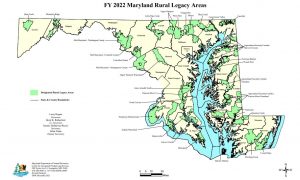
SNOW HILL– While Worcester County’s beaches might be the draw for most visitors, expanses of corn and soybeans are what herald their arrival to Maryland’s coast. Though it lacks the glamour of tourism, agriculture has been and remains a vital local industry.
Encouraging future generations to continue the county’s rural traditions when the lure of quick cash is thrown out by developers, however, isn’t always easy. Sometimes, whether they want to or not, the only way for a family to keep their farm is to begin selling off pieces of it. Maryland’s Rural Legacy Program, which pays landowners for conservation easements, aims to provide an alternative.
“These programs are often the life blood for landowners wishing to hold on to the family farm,” said Kate Patton, executive director of Lower Shore Land Trust. “If we are to maintain strong resource-based industries on the Shore, these programs are a vital tool for protecting farms, forests and natural resources.”
The Maryland General Assembly enacted the Rural Legacy Program in 1997 as a means to prevent sprawl and protect rural landscapes and natural areas. With funding from Program Open Space and general obligation bonds from the state’s capital budget, the program gives landowners the chance to sell their development rights but retain ownership of the property to continue growing crops or raising livestock. Statewide 1,072,038 acres are designated in Rural Legacy Areas, with at least one area in each county.
“The program directs resources to conserve large, contiguous tracts of land that support natural ecosystems, agriculture and forestry, and prioritize lands that most directly impact our bays, rivers and creeks,” Patton said.
Worcester County has two Rural Legacy Areas—Dividing Creek and Coastal Bays. Each year, the county applies for funding from the state to buy conservation easements. On Tuesday, the Worcester County Commissioners approved the fiscal year 2022 grant agreement with the state, which provided the county with $760,000 for the Coastal Bays Rural Legacy Area and $1,005,000 for the Dividing Creek Rural Legacy Area. Statewide, $26 million was granted through the Rural Legacy Program in fiscal year 2022.
“This program is funded by state (Program) Open Space money and general obligation bonds from the capital budget so it costs us nothing,” said Bob Mitchell, the county’s director of environmental programs. “This will be used to fund three to five conservation easements with rural land owners in the next 18-month cycle.”
The funding from the state pays for the purchase of the perpetual easement and reimburses the county for administrative costs. When applications from property owners interested in the program are evaluated, various items are considered. Officials review the significance of the agricultural, forestry and natural or cultural resources proposed for protection, the threat to those resources from development pressure, the significance of cultural resources proposed for protection and the economic value of the resource based industry (such as agriculture and forestry) on the land.
Twenty-five years after the Rural Legacy Program was created, it continues to play a key role in conservation.
“The interest from landowners has never been stronger and the support of these programs is a direct investment in our local communities,” Patton said.
Attorney Hugh Cropper, who has conservation easements on some of his property and has represented others who have participated in the Rural Legacy program, has seen a shift in the public perception in recent years. When landowners once talked about selling development rights, they now talk about protecting property.
“People have developed an appreciation for open space,” he said.
Twenty years ago, he said, an easement might have hurt a farm’s value. Now, if it’s surrounded by other Rural Legacy properties he believes its value is higher. People are eager to buy property when they know the land surrounding it will remain undeveloped.
“They know it’ll be open space in perpetuity,” he said.
According to the Maryland Department of Natural Resources website, since its inception the Rural Legacy Program has dedicated more than $384 million to preserve more than 111,000 acres. The agency cites the program’s commitment to preserving large tracts of land to enhance agricultural and environmental protection while supporting a sustainable land base for natural resource based industries.
“The program creates public-private partnerships and allows those who know the landscape best – land trusts and local governments – to determine the best way to protect the landscapes that are critical to our economy, environment and quality of life,” the agency’s website reads. “The program encourages local governments and land trusts to work together and determine how best to protect their vital working landscapes.”

